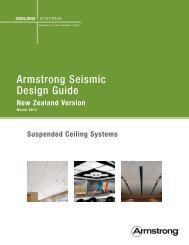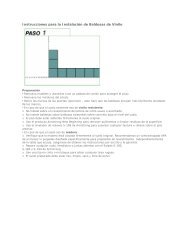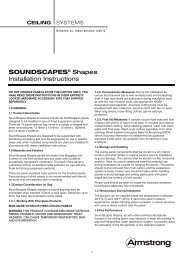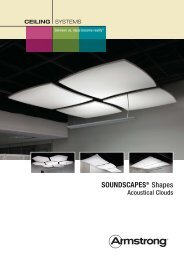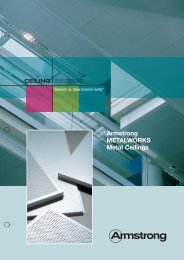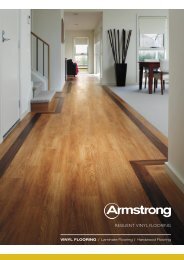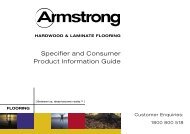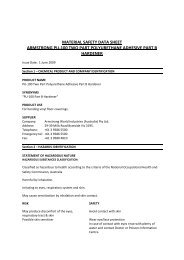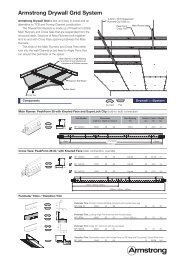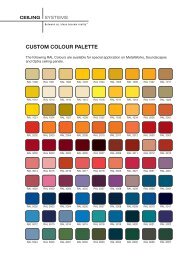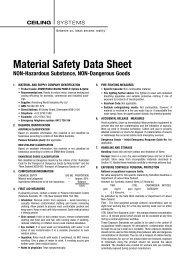Installation - Armstrong-aust.com
Installation - Armstrong-aust.com
Installation - Armstrong-aust.com
You also want an ePaper? Increase the reach of your titles
YUMPU automatically turns print PDFs into web optimized ePapers that Google loves.
ACCOLADE SAFE<br />
ENGINEERED INSTALLATION SYSTEM<br />
QUICK REFERENCE GUIDE<br />
<strong>Installation</strong>: Conform to AS 1884 – 1985<br />
Types of subfloors:<br />
<strong>Installation</strong> system:<br />
Pattern match:<br />
Coving:<br />
Concrete – timber<br />
Full spread, heat-welded seams<br />
No match – reverse edges<br />
Readily coveable with pre-formed cove fillet<br />
Adhesives: Dry Area SV-200<br />
Wet Area PU-100<br />
Trowel size:<br />
Special precautions:<br />
Re<strong>com</strong>mendations:<br />
Weld rod:<br />
1.6mm deep, 1.6mm wide, 2.4mm apart<br />
(S-891 notched steel trowel)<br />
Do not roll material face in<br />
Allow to acclimatise to room temperature (18°C)<br />
Remove factory edges<br />
Ensure batch numbers are the same and rolls<br />
are installed in roll order<br />
Use matching weld rod as per colour chart<br />
All Safeguard ranges are exclusively imported<br />
by <strong>Armstrong</strong> World Industries (Australia) Pty. Ltd.<br />
Accolade Safe Plus is manufactured in Australia<br />
Form: F3210 October 2001 1
INSTALLATION INSTRUCTIONS<br />
INITIAL PROTECTION:<br />
<strong>Armstrong</strong> highly re<strong>com</strong>mends the installed floorcovering be<br />
protected from construction site debris, dirt, soil, traffic and<br />
stains, all of which can damage the unprotected flooring.<br />
Do not tape protection to the surface.<br />
Responsibility for the protection of the finished work until<br />
handed over to the client should be arranged prior to<br />
installation.<br />
TO THE INSTALLER:<br />
Please note that if material has been cut, fitted, or installed,<br />
NO ADJUSTMENTS or CLAIMS (if any) will be considered due<br />
to the failure to <strong>com</strong>ply with any of the following. Before<br />
cutting and installing <strong>Armstrong</strong> floorcoverings make sure that<br />
you:<br />
1. Check for obvious manufacturing defects in good daylight<br />
conditions.<br />
2. Check that the material is the correct colour, pattern and<br />
quantity ordered by the customer.<br />
3. Material should be allowed to acclimatise to job climatic<br />
conditions for 24 hours at 18°C. Never install the material<br />
if the temperature in the room is less than 15°C as per<br />
Australian Standard AS 1884 – 1985 Section 3 – 1.<br />
4. Use only <strong>Armstrong</strong> re<strong>com</strong>mended adhesive specifically<br />
formulated for <strong>Armstrong</strong> product.<br />
5. All rolls of <strong>Armstrong</strong> products are marked with a ‘batch<br />
number’. When using more than one roll make sure the<br />
rolls have the same ‘batch number’.<br />
6. All batches are numbered in roll order. Install in roll order.<br />
7. After loosely laying the first two strips, before adhering,<br />
step back and inspect the overall effect. If acceptable,<br />
then go ahead and adhere, but if there seems to be a<br />
problem or doubt of any kind then stop immediately and<br />
call the distributor or <strong>Armstrong</strong> Customer Service on<br />
1800 632 624.<br />
8. Do not cut or install any damaged or defective material<br />
unless accepted, agreed and approved by all parties<br />
concerned.<br />
PLEASE NOTE: Existing resilient flooring backing, or lining<br />
felts should NOT BE SANDED. These products may contain<br />
asbestos fibres that are not readily identifiable. You should<br />
note the details in the ‘WARNING’ panel set out later in these<br />
instructions BEFORE YOU PROCEED ANY FURTHER. If you<br />
have satisfied the requirement of the warning then, providing it<br />
does not conflict with any applicable laws, the following<br />
procedure is suggested to remove existing resilient<br />
floorcoverings.<br />
The wear layer should be cut into narrow strips, being careful<br />
not to score the subfloor. The narrow strips should then be<br />
peeled from the backing by pulling or rolling around a core<br />
which will control the stripping angle and create a uniform and<br />
more constant tension. After the wear layer has been<br />
removed, the remaining felt should be scraped by using<br />
scrapers (MUST NOT SAND).<br />
Any unevenness in the subfloor due to scraping should be<br />
levelled and smoothed using an underlayment as per<br />
manufacturers re<strong>com</strong>mendations.<br />
SUBFLOORS<br />
The condition of the subfloor not only has an important bearing<br />
on the appearance of the finished installation, but can<br />
dramatically affect the life and serviceability of the<br />
floorcovering. It is essential, therefore, that the subfloor be<br />
dry, hard, rigid, smooth, level, clean and free of dust and<br />
grease.<br />
CONCRETE SUBFLOORS<br />
Concrete subfloors must be cured and <strong>com</strong>pletely dry. The<br />
surface must be steel trowelled to a smooth dense surface free<br />
of trowel marks, irregularities, as per Australian Standards.<br />
Concrete slabs in contact with fill, hardcore or the ground must<br />
have a damp-proof membrane to prevent entry of moisture.<br />
Water proofing additives and curing <strong>com</strong>pounds do not replace<br />
the damp-proof membrane. New slabs should dry for at least<br />
one month per 25mm thickness.<br />
Care must be taken to ensure that the surface of the concrete<br />
is free of parting or curing <strong>com</strong>pounds, oil, grease, paint, dust<br />
and any other substances, which may prevent the adhesive<br />
from forming a secure bond. The surface of the concrete must<br />
be smooth and level, <strong>com</strong>pletely free of cracks, holes and<br />
protrusions.<br />
If the surface is not satisfactory it should be repaired and<br />
levelled with a cementitous underlay, applied according to<br />
manufacturers re<strong>com</strong>mendations.<br />
When curing <strong>com</strong>pounds, hardeners, sealers, or parting<br />
<strong>com</strong>pounds have been used, they have to be <strong>com</strong>pletely<br />
removed by sanding, sandblasting or grinding prior to the<br />
installation of materials as this will impair the bond of the<br />
adhesive. A MOISTURE TEST SHOULD ALWAYS BE<br />
CARRIED OUT PRIOR TO INSTALLATION.<br />
Form: F3210 October 2001 2
IMPORTANT: PLEASE READ CAREFULLY BEFORE YOU START<br />
HEATED SUBFLOOR<br />
Slip Retardant flooring can be installed over heated subfloors.<br />
However, it is imperative that the temperature at the surface of<br />
the slab does not exceed 28°C. Prior to the installation,<br />
heating should be turned on for a number of days to remove all<br />
traces of residual dampness that may be present in the<br />
subfloor. The heating should be turned off 48 hours prior to<br />
and during the installation and should not be turned on until 48<br />
hours after the installation is <strong>com</strong>pleted, in order to allow the<br />
adhesive to set.<br />
TIMBER SUBFLOOR<br />
All timber subfloors must have at least 450mm of good cross<br />
ventilation under the floor to prevent distortion and movement<br />
of flooring members as well as excessive movement of<br />
underlay. New timber subfloors should be rigid, sound and<br />
constructed of seasoned timber and free from excessive<br />
cupping and warping.<br />
Old timber subfloors should have all loose boards re-nailed<br />
and badly worn or damaged boards must be replaced. If<br />
necessary, sand floor to a level finish without undulations.<br />
Overlay subfloor with hardboard or approved fibrous cement<br />
vinyl flooring underlayment. The underlay sheets must be<br />
fastened at 75mm intervals around all sides, 10mm from<br />
edges, and at 100mm to 150mm intervals throughout the body<br />
of the board.<br />
The sheet shall be fastened by 25mm x 2mm ring-grooved<br />
nails, or chisel point staples for hardwood subfloors and<br />
divergent point staples for softwood subfloors. Hardboard<br />
must be laid smooth side up and all joints should be staggered.<br />
All joints and any raised edges of the underlay shall be sanded<br />
smooth and level. The sanded areas must be sealed prior to<br />
the installation of the floorcovering as re<strong>com</strong>mended by the<br />
manufacturer.<br />
Underlay must be installed over structural particleboard using<br />
the adhesive and nailing fixing system specified by the<br />
underlay manufacturer.<br />
EXISTING RESILIENT FLOORS<br />
<strong>Armstrong</strong> re<strong>com</strong>mends the removal of existing resilient floors.<br />
If this is not practical, adequate care should be taken to ensure<br />
the existing resilient floor is to an acceptable standard to<br />
receive new floorcoverings.<br />
The existing resilient floor must be smooth (not textured, or<br />
embossed, enough to show through the final installation),<br />
<strong>com</strong>pleted and firmly bonded and properly installed on<br />
re<strong>com</strong>mended subfloors. Existing resilient floor must not be<br />
cushioned, and must have no evidence of moisture, alkaline<br />
salts or hydrostatic pressure. Polish and other finishes should<br />
be removed from existing floorcovering by thorough stripping.<br />
Indentations and damaged areas should be replaced or<br />
repaired.<br />
<strong>Installation</strong> over existing resilient floors reduces resistance to<br />
indentations.<br />
NOTE: Existing resilient flooring may contain asbestos fibres,<br />
which are not really identifiable. You should note the details in<br />
the ‘WARNING’ panel set out later in these instructions before<br />
you carry out these steps.<br />
JOB CONDITIONS<br />
Job conditions should be as outlined in Australian Standard AS<br />
1884 - 1985 - 3 - 1. Temperatures in areas to be covered<br />
should be maintained at a minimum 18°C for 48 hours prior to,<br />
during and after installation. Please note that cold subfloors<br />
have considerable influence on the open time of flooring<br />
adhesive.<br />
SEAMING INSTRUCTIONS<br />
HEAT WELD<br />
• All factory edges should be removed during installation.<br />
• Scribe seams using <strong>Armstrong</strong> S-83 Recess Scriber set to<br />
provide a gap of 0.5mm – 1.0mm. Cut to scribe line and<br />
roll cut edges into adhesive using hand roller. Roll entire<br />
floor using 45kg roller.<br />
• Heat welding should only be done when adhesive is<br />
<strong>com</strong>pletely cured (24 hours).<br />
• Rout or groove seam using a ‘V’ or ‘U’ shape to a<br />
minimum of ¾ of the material depth using a grooving<br />
machine or hand groover with a sharp blade against a<br />
straight edge, so that both sides of the seam are grooved<br />
equally and uniformly.<br />
• For best results and to reduce damage to the surface use<br />
an <strong>Armstrong</strong> S-65 speed nozzle.<br />
• Set temperature setting on the hot air welder, fitted with an<br />
S-65 speed nozzle, to deliver enough heat to fuse weld<br />
rod to sheet. Amperage of electrical supply, length of<br />
extension cord and wire size will affect the temperature<br />
setting. As a guide, a Leister weld gun fitted with an S-65<br />
speed nozzle should be set to heat setting of around 7.<br />
Practice on a piece of scrap material until correct setting is<br />
achieved.<br />
• Insert weld rod into the S-65 speed nozzle and<br />
immediately insert the rod into the groove.<br />
• Hold the gun at the proper angle so that the tip of the S-65<br />
speed nozzle is parallel with the material. A good weld<br />
will result when the rod just starts to flair, and no more, on<br />
each side of the seam. If the rod flairs excessively you<br />
are going too slow, the <strong>Armstrong</strong> weld rod should<br />
ultimately fall apart before scorching the material if the<br />
heat setting is correct.<br />
• To change directions in welding, shave off excess welding<br />
rod and groove the end of the rod for approximately<br />
20mm. Start welding from the opposite direction and<br />
continue welding until you overlap the initial grooved weld<br />
rod and continue for another 20mm before lifting weld off.<br />
• Allow weld rod to <strong>com</strong>pletely cool before skiving<br />
(trimming).<br />
• Once weld rod is cooled off, skive off in two passes. The<br />
first pass using a quarter moon (spatula) knife with a trim<br />
plate. The second pass should be flush with the material.<br />
Too much weld rod flair or an uneven seam will result in<br />
the top surface of the material being removed exposing<br />
the material backing.<br />
Form: F3210 October 2001 3
WARRANTY<br />
Product:<br />
<strong>Armstrong</strong> warrants its regular (first quality) products to be free from manufacturing defects for five (5) years from the date of purchase.<br />
This warranty is extendable to ten (10) years should the re<strong>com</strong>mended <strong>Armstrong</strong> engineered installation system be followed.<br />
<strong>Installation</strong>:<br />
<strong>Armstrong</strong> warrants the installation integrity of our products only for ten (10) years from the date of purchase. <strong>Installation</strong> integrity<br />
means that the products are installed according to <strong>Armstrong</strong>’s expressed written re<strong>com</strong>mendations using the <strong>Armstrong</strong> engineered<br />
installation system.<br />
NOTE: Vinyl flooring manufactured in Australia after January 1, 1984, DOES NOT contain asbestos. However, regulations, codes and<br />
directives as to the best method of handling asbestos do exist and it is the obligation of the installer to ensure that practices used are<br />
safe, without risk to health, and meet all legal requirements.<br />
ALL ARMSTRONG WORLD INDUSTRIES (AUSTRALIA) PTY. LTD.<br />
FLOORCOVERINGS, ADHESIVES & ACCESSORIES ARE MANUFACTURED ASBESTOS FREE<br />
!!!!!<br />
!<br />
WARNING<br />
Do not sand, dry sweep, dry scrape, drill, saw, beadblast, or mechanically chip or pulverise existing resilient flooring,<br />
backing, lining felt or asphaltic ‘cut-back’ adhesives.<br />
These products may contain either asbestos fibres or crystalline silica.<br />
Avoid creating dust. Inhalation of such dust is a cancer and respiratory tract hazard.<br />
Smoking by individuals exposed to asbestos fibres greatly increases the risk of serious bodily harm.<br />
Unless positively certain that the product to be removed is a non-asbestos containing material, you must presume it contains<br />
asbestos. Regulations may require that the material be tested to determine asbestos content.<br />
Note: Vinyl flooring manufactured in Australia after 1 st January, 1984 does not contain asbestos.<br />
Disclaimer – Asbestos issues<br />
The warnings and guidance contained in these instructions in relation to the potential for asbestos in floorcovering materials are given<br />
in good faith. However, regulations, codes and directives as to the best method of handling asbestos are under continual revision. It is<br />
the obligation of the installer to ensure that practices used are safe, without risk to health, and meet all legal requirements.<br />
<strong>Armstrong</strong> World Industries (Australia) Pty. Ltd. accepts no liability for any loss, costs, expense or injury, however incurred, arising from<br />
the presence of any asbestos in any floorcovering materials or asphaltic ‘cut-back’ adhesives and/or any reliance placed upon the<br />
procedures and re<strong>com</strong>mended practices contained in these instructions.<br />
Initial Care:<br />
After installation is <strong>com</strong>pleted:<br />
1. Remove all debris from floor (electrostatic mop or vacuum).<br />
Allow 48 hours before carrying out the following:<br />
2. Damp mop/scrub using a neutral cleaner (<strong>Armstrong</strong> ONCE ‘N DONE).<br />
3. Rinse floor thoroughly with clean water.<br />
Note: Do not use sealers and polish as this will impair the slip retardance.<br />
For Further <strong>Armstrong</strong> Information<br />
Freecall 1800 632 624<br />
www.armstrong-<strong>aust</strong>.<strong>com</strong>.au<br />
Form: F3210 October 2001 4




